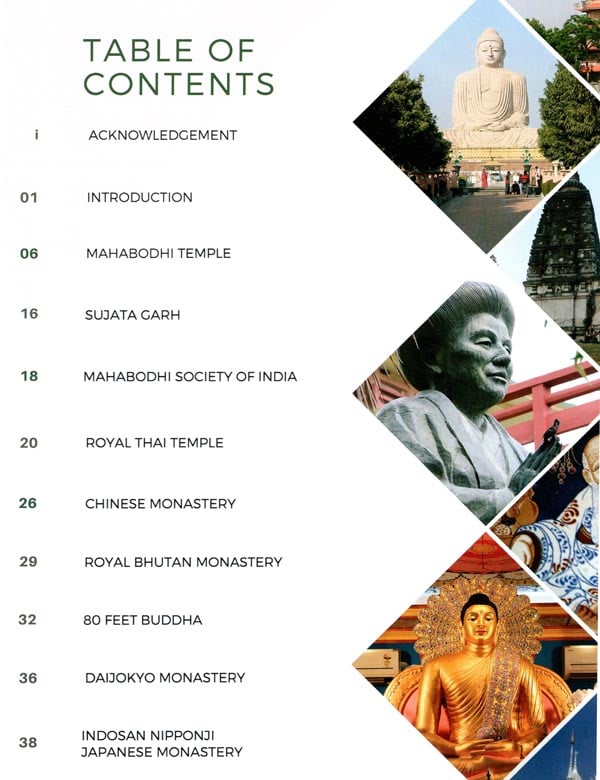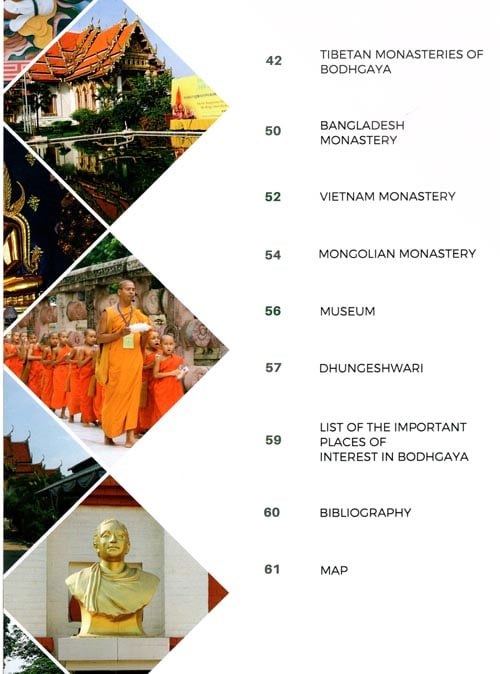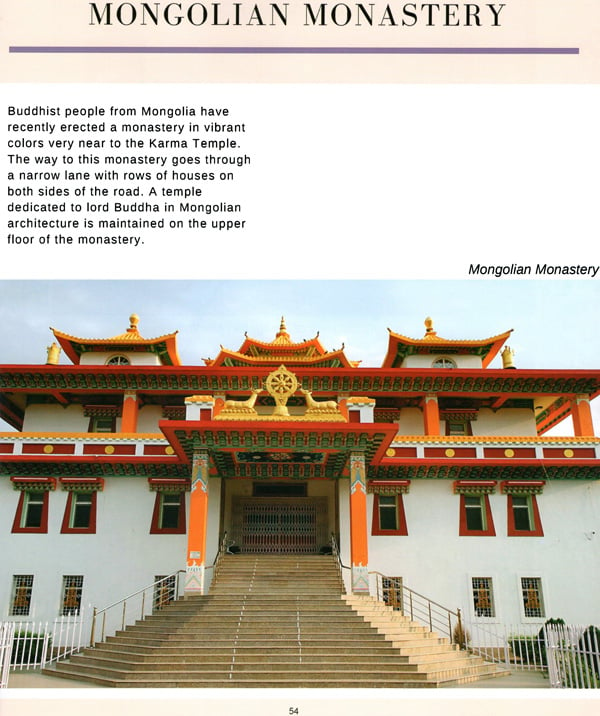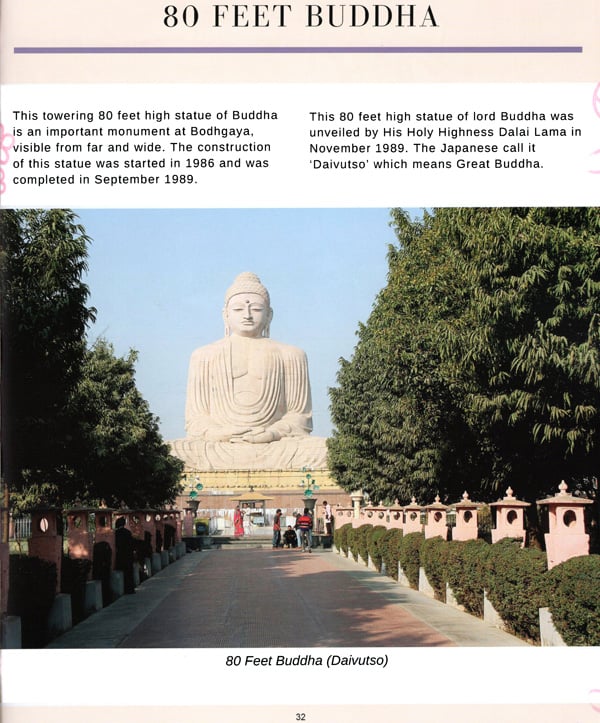
A Complete Guide to Bodhgaya (Land of Enlightenment)
Book Specification
| Item Code: | NAR092 |
| Author: | J.P. Sharma |
| Publisher: | Invincible Publishers |
| Language: | English |
| Edition: | 2018 |
| ISBN: | 9789388333085 |
| Pages: | 70 (49 Color Illustrations) |
| Cover: | PAPERBACK |
| Other Details | 10.00 X 8.00 inch |
| Weight | 260 gm |
Book Description
Sermon of Buddha - the Four Noble Truths and the Eight Fold Path was something that moved the author to the core of his heart to travel to all the Buddhist sites, not only once but again and again. Through his rigorous research and wanderlust, he took it upon himself to travel across the length and breadth of the country and even beyond India to acquaint himself more about Buddhism. In 2016, he got a book 'Foot Prints of Gautam Buddha' published, which was highly liked and appreciated not only by the people of faith, but 'everyone in general.
There was high demand of a book on Bodhgaya exclusively. Keeping it in mind, he made several visits to Bodhgaya and made several interactions with the officials of Bodhgaya Temple Management Committee and Mahabodh Society of India, as well as the priests and bhikhus of monasteries of various countries like Thailand,Tibet, Japan, Bhutan, China and Bangladesh to produce a book on Bodhgaya. Thus it encompasses all the main temples, stupa and monasteries from ancient to modern times. This book is now in your hands. The author has taken special pains to capture the spirit and environment of the holy place through his lense.
Siddhartha, the royal prince, meditated deeper and deeper under a Bodhi tree (pipal tree) in Uruvella on a full moon, and realised that he knew the truth. He understood why the world was full of suffering and unhappiness and how mankind could overcome those miseries of life two thousand and five hundred years ago. He had found the cause of sorrow and became enlightened - a Buddha.
According to the traditions of those days, his mother Mahamaya Devi was going to Devdaha, the home of her parents in Koliya Kingdom, to deliver her child. When Mahamaya entered the forest of Lumbini in the Tarai region of Nepal, trees of the forest bowed down to her in welcome and said,' Enjoy this lovely garden of angles.' Queen Mahamaya Devi halted in Lumbini garden, walked around and eventually by holding the branch of a tree, gave birth to the holy child named Siddhartha, meaning the one who has fulfilled the purpose.
Mahamaya Devi had a dream before the birth of prince Siddhartha that a white elephant holding a lotus was entering her womb. Royal soothsayers predicted that the newly born child would either be the universal monarch or the enlightened one; 'Chakravartin' or 'Buddha'. Sage Asita visited Kapilvastu after the birth of this child. He laughed and shed tears upon seeing him. When asked the reason, the sage replied that he had laughed because the child would become a savior, and shed tears because he would be no more to see this. Prince Siddhartha's mother died just 7days after his birth, and he was brought up by his maternal aunt PrajapatiGautami.
Historians believe that Buddha was born in 563 or 566 B.C. and died (attained nirvana) in 483 or 486 B.C. Therefore, he lived during 5th and 6th-century B.C.which was the period of great intellectual movement in the world. Confucius and Lao-Tse in China, Zoroaster in Iran, and Mahavira in India were contemporaries, of Lord Buddha. During this period, there existed many developed cities in India like Magadha, Vaishali, Kapilvastu, Avanti, Kalinga, Videh Ang, Kasi and Pava, which were all well-managed states.
Utmost care was taken in the upbringing of Prince Siddhartha. All worldly pleasures were provided to the royal prince. prince Siddhartha was married to a beautiful princess Yashodhara (Bhadra Kapalayani)of Koliya king. A son was born to them and was named Rahul, as Siddharthaconsidered his son an obstacle in his spiritual path. In spite of all materialistic pleasures, the sights of an aged man, disease, and death made him realise the futility of the materialistic world. One night, leaving his wife Yashodhara and Rahul asleep, prince Siddhartha embarked upon the search for knowledge.
After leaving home, Siddhartha practiced austerities for about six years. Alar Kalam and Udrak Ramputra were unable to quench the spiritual thirst of Siddharth. As a result of practicing austerities, Siddhartha's body became weak and turned into a mere skeleton. He soon realised that this was not the right path. One day while meditating, he heard a song being sung by the women folk of the village. The song conveyed the message that do not tighten the strings of Veena (a musical instrument) so much that they break away, and do not loosen the strings so much that it cannot produce any music.
Siddhartha realised that the middle path (madhya marg) is the right path. He decided to have food. His five disciples thought that Siddhartha had chosen the wrong path, therefore they left him. He ate sweet rice cooked in milk (Kheer) given to him by Sujata, a village woman. In some a scriptures, it is mentioned that the Gods mixed amrit (elixir) in it. On a full moon night during Vaishakha (a month according to the Hindu calendar), Siddhartha attained wisdom (Bodhi) and became Buddha. At some places, it is called Sambodhi. After attaining enlightenment at Bodhgaya, Buddha decided to preach Dhamma to his a five erstwhile companions who had left him. Therefore, Buddha came to Sarnath near Kasi (present day Varanasi) and preached Dhamma for the first time. This event in Buddhism is called Dharmachakra Pravartan (turning the wheel of law).
During this time, the Vedas held supreme power in the religious domain and Brahmins were the sole custodians of religious activities. Caste system had also become Kalam quite deep rooted in the society by this time. Vedic rituals and animal sacrifices 1h. As became an important part of the religion. In this religious atmosphere, Gautam turned Buddha preached a new path of salvation that which was very simple. He preached the while Four Noble Truths of Arya .
Satya(Chatushatya): This world is full of miseries (Dukkha); Its cause is attachment (Samudaya); and by suppression(Nirodha) of all these attachments, Nirvana can be do not attained. Buddha preached the eightfold noble path (Arya Astangika Marg) called the middle path(Madhyam Marg), i.e. right view, right intention, right speech, right path actions, right livelihood, right awareness, right mediation and right contemplation. pies Buddha did not attach any importance to the matter of God or the soul because He ate they were beyond the ken of human riven to intellect. If a man desires to achieve some a goal, he is cautioned to avoid Gods involvement in complex and intricate loon matters concerning God and the soul. The cording moment he entangles himself, he is liable attained to forget his own self without solving his a. At problem. Buddha's approach to human . After liberation was unique in its own way and differed radically from all philosophical to his approaches or religious thoughts that left him. came before him. Buddha travelled to the i near then existing kingdoms of Kosala and eached Magadha i.e. Sarnath, Rajgir, Nalanda, nt in Kausambi, Shravasti, Sankisa, Kapilvastu, 'ravartan Vaishali and Kusinagar (situated in the present day provinces of Uttar Pradesh and Bihar of the Indian Union) and spread preme his teachings. After the demise of Buddha, 3rahmins Buddhism remained dormant for more than is two centuries.
With the rise of the Kushana dynasty in India, Buddhism entered a new phase. Kanishka gave patronage to Buddhism. During his time, Buddhism reached China and Central Asia. Gupta rulers were his worshippers of Vishnu, but during the of Gupta period, the art and architecture of As a Buddhist monuments attained new heights. Gupta rulers patronised Nalanda University the which was a great centre for Buddhist ted teachings. Chinese traveler Fahe in visited one Nalanda University in 409A.D. during the Gupta period, while Hiuen-tsang visited in shall 637 A.D.; during the reign of his Harshavardhan. Both the travelers have given glorious accounts of Buddhism in India. Traces of Buddhism are available all of the way up to 1100 A.D. during the rule of ?rant a Pala King from eastern India. During the wring rule of the Pala king, Vikramsila .5 University(situated in the present day district of Bhagalpur in the state of Bihar) was a great centre for Buddhist teachings. lia. These world famous centre of Buddhist d as learning were annihilated and the holy Ir. books and manuscripts were all burnt by a Muslim invader Bakhtiar Khilzi in 1235 A.D. t - 1236A.D. sagar. a Teachings of Buddha are preserved in the aim Tripitakas in Pali, namely: Suttapitak, f 20 Vinayapitak and Abhidhammapitak. These Pali tripitakas were not created at the same time or the same place. Pitakas were grah written at different times and at different i a places. Pali was the language of the iseum Magadha Empire and Buddha preached his I site sermons in Pali, thus it is regarded as )f the Buddha Vachan, authentic from the mouth of Buddha.
Just 3 months after the nirvana of Buddha, a dispute arose amongst the bhikshus regarding dhamma and vinay. To address the dispute, the first council (sangit) was organised in Rajgrah. The second council was organised a hundred years later in Vaishali, wherein some dispute relating to vinay was resolved. The third council was organised in Patliputra during the period of Asoka, and the Pali Tripitak were finalised in this council. The Pali Tripitak found today are the same which were given their final shape during the reign of Asoka. After the third council, Asoka sent his son.
Mahendra and his daughter Sanghmitra to Sri Lanka to propagate Buddhism. The fourth council was held during the reign of Kanishka in Kashmir. Since the period of Asoka, the two sects - Hinyan and Mahayan arose in Buddhism. With the course of time, Buddhism reached beyond the shores of India to Nepal, Sri Lanka, China, Japan, Thailand, Korea, Burma, Cambodia, Laos and Bhutan, and is now followed by millions. According to Albert Einstein, "If there is any religion that would cope with modern scientific needs, it would be Buddhism."











